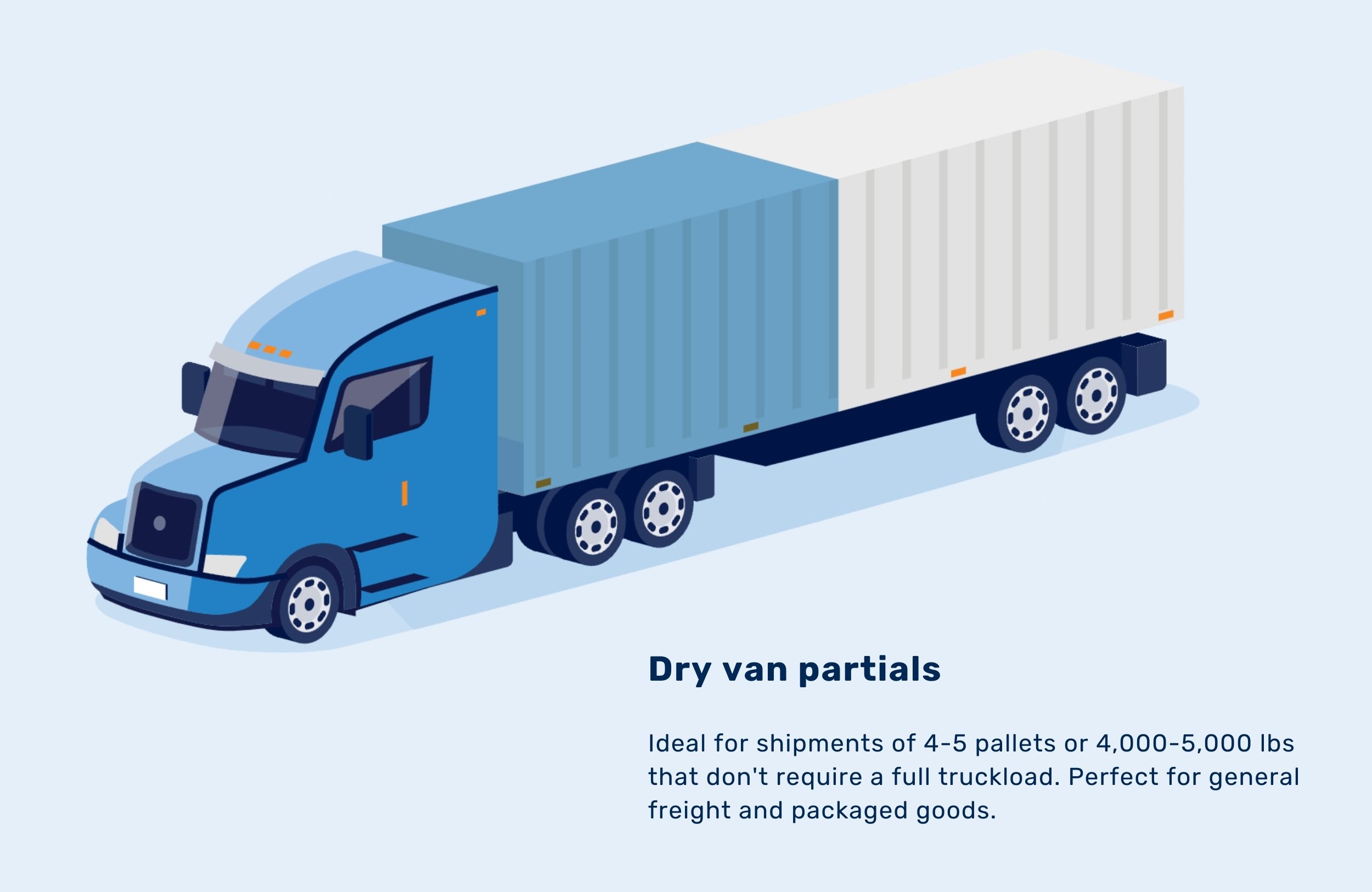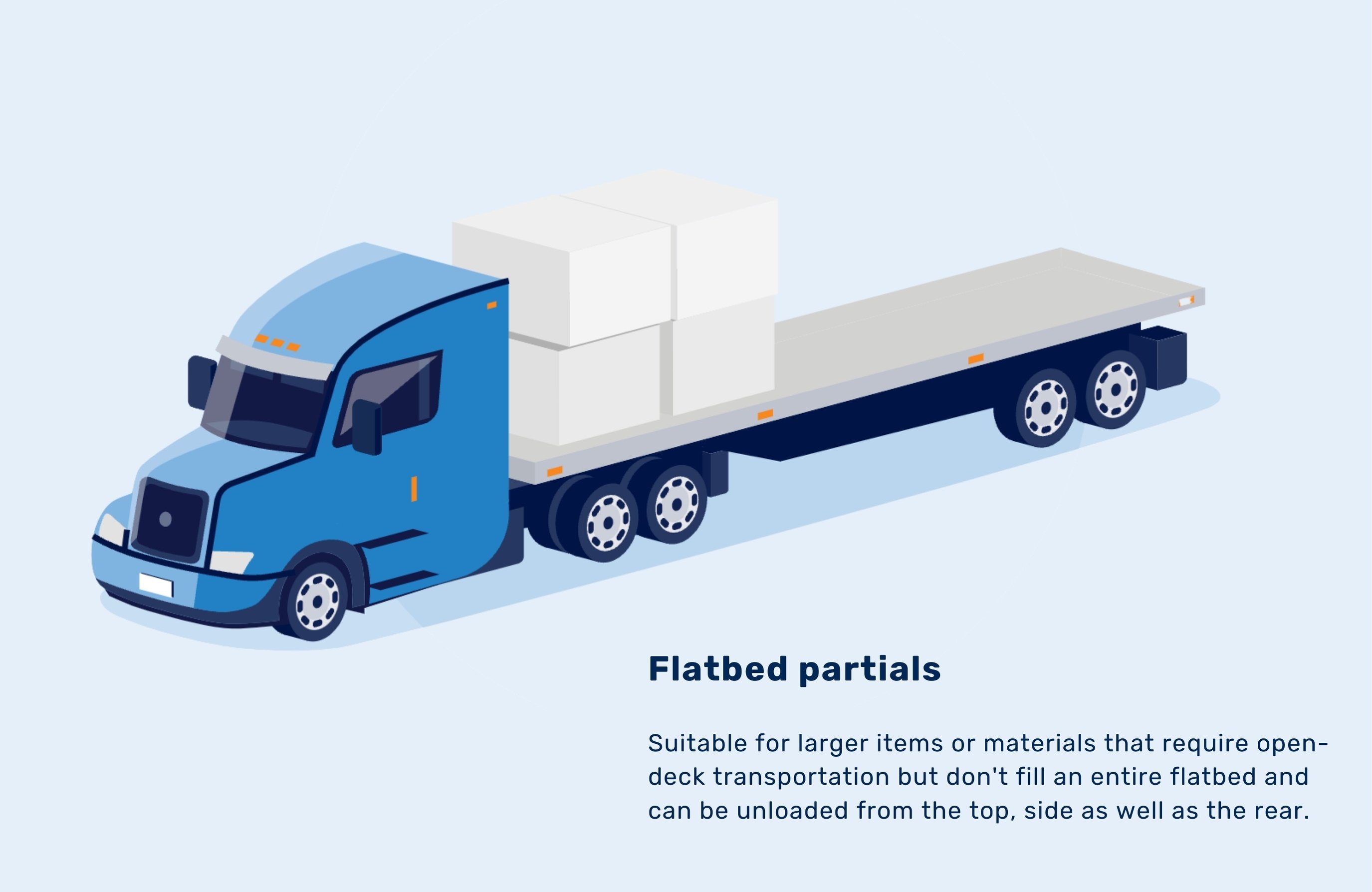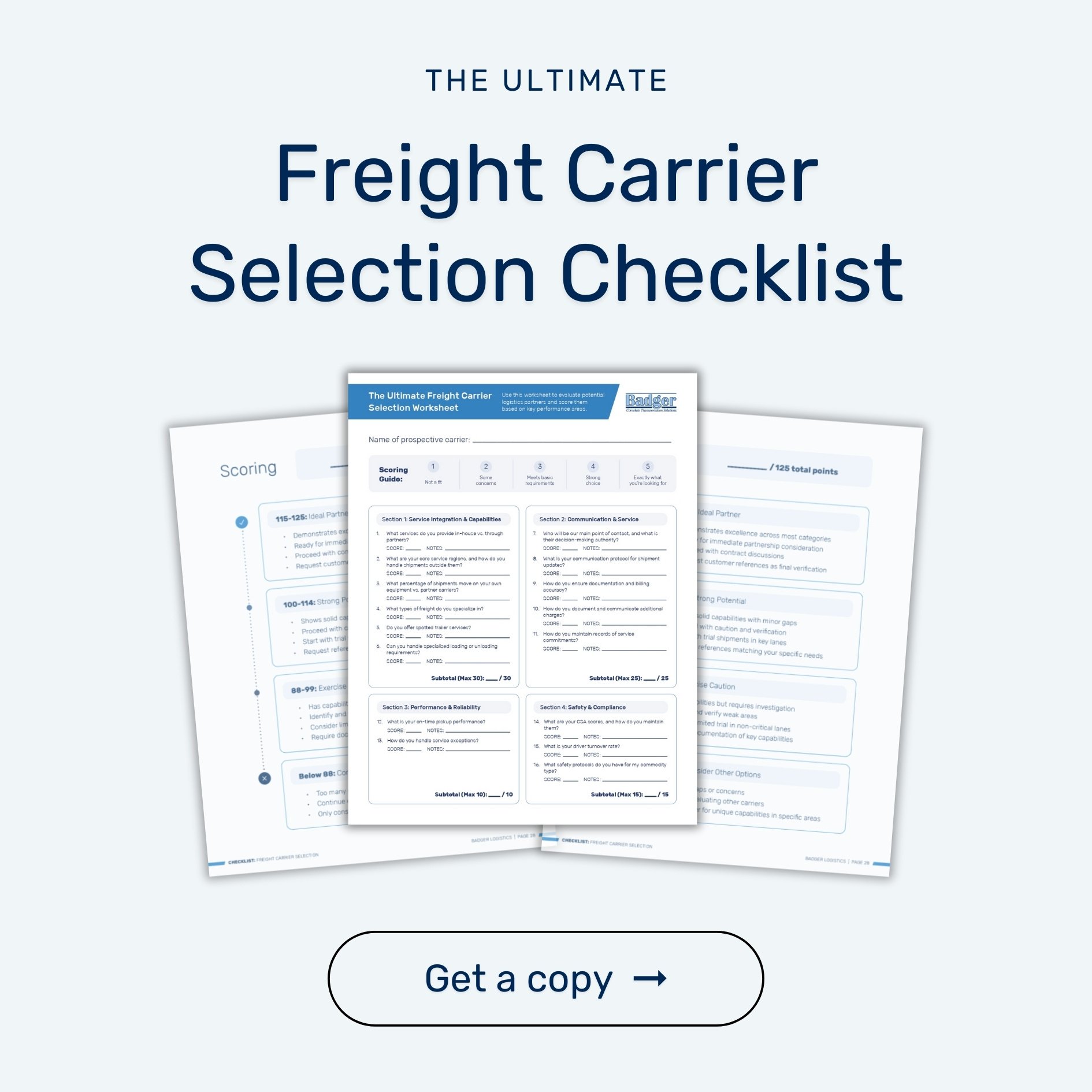Key takeaways
- Partial truckload shipping is ideal for shipments that are too large for LTL but don’t require a full truck, offering better protection, flexibility, and cost-efficiency for "tweener" sized freight.
- Unlike LTL, partial shipments follow a more direct route with fewer handling points, reducing the risk of damage and ensuring better service quality.
- Partial shipping is often the better choice for damage-sensitive freight, high-value goods, and when scheduling flexibility or dedicated service is essential.
- Selecting between LTL and partial shipping requires considering shipment size, distance, timing, and fragility, with the optimal approach tailored to your specific shipping needs.
Badger Logistics delivers expert partial shipping services for reliable and efficient transportation of your mid-sized freight. Learn more about our partial freight services and get a competitive rate quote to join hundreds of shippers discovering a better alternative to traditional LTL.
A brief introduction
After decades in the transportation industry, we’ve seen how choosing the right shipping method can make or break your supply chain efficiency. Two options that often cause confusion are Less Than Truckload (LTL) and partial truckload shipping.
While they might seem similar at first glance, understanding their key differences can save you time, money, and headaches.
The basics: defining LTL and partial loads
Let's start with what exactly we mean by each term. Traditional LTL shipping involves combining multiple small shipments from different customers into one truck, using a hub-and-spoke distribution system. Each shipment typically takes up a small portion of the trailer.
Partial truckload (PTL) shipping, on the other hand, generally involves shipments that are too large for standard LTL but don't require a full truck.
In our experience, this usually means shipments that:
- Take up 4 or more pallet spaces
- Weigh 4,000-5,000 pounds or more
- Are too large for standard LTL but don't need a full 53' trailer


If you'd prefer more detailed definitions:
|
What does Less Than Truckload (LTL) mean? Less Than Truckload shipping refers to the transportation of freight that doesn't require a full truckload and is typically too large for parcel delivery. In LTL shipping, multiple shipments from different customers share space on the same truck. This freight typically moves through a "hub and spoke" system where shipments are picked up, brought to an origin terminal, loaded onto a trailer, delivered to a destination terminal, and then delivered to the final recipient. What does partial truckload mean? Partial Truckload (PTL) shipping falls between LTL and Full Truckload (FTL) services. It's designed for shipments that are too large for traditional LTL but don't require a full truck. Typically, partial truckload shipments involve freight that takes up 4-5 pallet spaces or weighs 4,000-5,000+ pounds. Unlike LTL, partial shipments usually move directly from shipper to receiver without transferring between multiple hubs, resulting in less handling, reduced damage risk, and typically faster transit times. Partial shipments also benefit from full cargo insurance coverage rather than the limited coverage often found with traditional LTL carriers. |
Key differences in how they move freight
The biggest difference between LTL and partial is how the freight actually moves.
With traditional LTL, your shipment goes through multiple handling points:
|
Partial shipments take a more direct route. They're typically loaded once at pickup and delivered straight to the final destination. This means less handling of your freight and reduced risk of damage.
When to choose partial over LTL
Having spent years helping teams decide which option was better for their freight, partial shipping tends to be the better choice when:
1. You have damage-sensitive freight
When you’re shipping damage-sensitive items, every time your freight gets handled introduces risk. Think about how traditional LTL works: your shipment might get loaded and unloaded 4-5 different times as it moves through various terminals. Each time, there’s a chance for damage.
Let’s say you’re shipping delicate equipment or high-value manufactured goods. With partial shipping, your freight typically gets loaded once at pickup and unloaded once at delivery. It’s moving on the same truck the whole way, often with just your freight and maybe one or two other compatible shipments. This drastically reduces the chances of damage compared to being moved through multiple terminals and trucks in the LTL network.
2. You need flexibility
LTL carriers run on very rigid networks — think of it like a bus schedule. They have set routes and times, and your freight needs to fit into their schedule.
But sometimes business doesn't work that way. Maybe you need a pickup late in the day, or your customer has specific delivery time requirements.
With partial shipping, you often have more room to negotiate pickup and delivery times because you're dealing with carriers who can be more flexible. Since they're not tied to a fixed terminal network, they can often accommodate special timing requests that would be impossible in the LTL world.
3. Your shipment is "tweener" sized
This is where things get really interesting from a cost perspective. Picture a shipment that takes up about 8-10 feet of trailer space — roughly 8-10 pallets.
With LTL, you're paying premium rates because it's a large shipment for their network. However, it's not enough to justify the cost of a full truckload.
|
This is the sweet spot for partial shipping. Carriers can combine your shipment with one or two others going in the same direction, giving you better rates than LTL while still providing more dedicated service than you'd get in the LTL network. |
It's especially cost-effective for longer distances because carriers can better optimize their space and routes.
4. You value dedicated service
When you ship LTL, your freight becomes part of a massive network. Think of it like checking a bag with a major airline with multiple connections. You might know it's supposed to arrive Tuesday, but tracking specific details can be challenging because your shipment is moving through so many hands.
With partial shipping, you're typically getting more dedicated service. Your freight is on one truck, with one driver, moving directly to its destination. This means better visibility and control. If there's a delay or issue, you're dealing with one carrier who knows exactly where your freight is and what's happening with it.
This visibility and accountability can be invaluable for businesses where tight control over their supply chain is crucial.
Understanding these differences and knowing when to leverage partial shipping can lead to significant improvements in your shipping operations — not just in terms of cost, but also in reliability, damage prevention, and overall service quality. It's about matching the right shipping method to your specific needs, rather than trying to force everything into the traditional LTL model.
The key is working with a provider who understands both options and can help you evaluate which approach makes the most sense for each shipment. Sometimes that might mean using LTL for smaller shipments and partial for larger ones, creating a flexible strategy that optimizes your entire shipping operation.
Cost considerations
While exact savings vary by lane and shipment, partial can offer significant cost advantages over LTL for larger shipments, especially on longer hauls. The pricing advantage typically increases with:
|
However, traditional LTL carriers usually offer better rates for very small shipments (1-3 pallets) due to their efficiency in handling small loads.
Insurance and liability coverage
One often-overlooked advantage of partial shipping is better cargo coverage. Many LTL carriers limit their liability to a certain amount per pound, which can leave you underprotected for higher-value goods.
Partial shipments typically move under full cargo insurance coverage (usually up to $100,000), providing better protection for your freight.
Technology and tracking
While many large LTL carriers offer sophisticated tracking systems, partial shipments often rely more on direct communication with your provider.
At Badger Logistics, we compensate for this through regular manual updates and personalized service — you're dealing with real people who know your business, not just tracking numbers in a system.
Making the choice: what to consider
When deciding between LTL and partial shipping, ask yourself:
|
Remember, these factors work together. A high-value, damage-sensitive shipment might justify partial shipping even if smaller than typical. The best solution often involves using both methods strategically based on each shipment's specific needs."
— Drew Kirkman, Badger Logistics
LTL vs. partial shipping: best practices for success
Whichever method you choose, here are some tips for success:
1. Be clear about your requirements.
Communicate any special handling needs, delivery restrictions, or timing requirements upfront. Carriers need comprehensive information about:
- Special handling needs: Does your freight need lift gates, pallet jacks, or driver assistance?
- Delivery restrictions: Does your delivery location lack a loading dock, have limited hours, or require appointments?
- Timing requirements: Specify if you need guaranteed delivery dates or specific delivery windows. Precise arrival times are especially important for construction and manufacturing clients where installation crews might be waiting.
- Product specifics: Communicate exactly what you're shipping. Certain products may require specialized carriers with appropriate experience and equipment.
2. Know your dimensions.
Accurate weights and measurements are crucial for getting accurate quotes and avoiding issues.
- Weight and dimensions: Provide precise weight, length, width, and height measurements for your shipment.
- Stackability: Indicate whether your freight can be stacked or requires dedicated floor space. This significantly impacts pricing and capacity planning.
- Pallet specifications: Different pallet sizes (48x40, 50x60, etc.) affect rates differently, with non-standard sizes often incurring premium charges.
- Total trailer space required: For partial loads, indicating the linear feet of trailer space needed helps carriers optimize loads and provide accurate pricing.
3. Consider flexibility.
You might get better rates and service options if you can be flexible with pickup or delivery times.
- Pickup and delivery times: Carriers prefer daytime pickup/delivery (typically 7am-3:30pm).
- Rate variations: Carriers often have excess capacity on certain lanes or days. Being flexible allows you to take advantage of these opportunities.
- Lead time: While many shippers expect 24-hour turnaround, providing more lead time when possible can result in better rates and more carrier options.
- Seasonal considerations: Certain seasons (like produce season) dramatically affect capacity and rates. Building flexibility into your shipping schedule helps navigate these fluctuations.
4. Build relationships.
Find a provider you trust and build a relationship. This pays dividends when you need special accommodation or have time-sensitive shipments. Maintaining regular contact, even without immediate shipping needs, keeps you top-of-mind when opportunities arise.
Remember, there's no one-size-fits-all solution in transportation. The best approach is often working with a provider who understands both options and can help you choose the right service for each specific shipment. Don't be afraid to ask questions and discuss your needs in detail — that's how you build the most efficient shipping solution for your business.
Jump to:
Need a partial freight partner?
Join hundreds of shippers discovering a better alternative to traditional LTL with dry van or flatbed partials.





